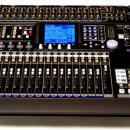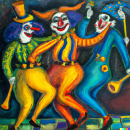hola a todxs!
En estos momentos ando inmerso en un proyecto para un corto.
la canción que estoy haciendo ahora es sobre la temática de los años 20.
adjunto video para ponernos en situación :
https://www.youtube.com/watch?app=desktop&v=0PUh1sTkhrs
Mi duda o problema viene siendo como obtener ese sonido tan caracteristico de gramola, he probado con el vinyl de waves para añadir chisporreteos,aunque no llega a parecerse.
Otros de los problemas que me surgen es que los instrumentos usados(trompeta,saxo,etc) , via kontakt, suenan tremendamente bien y no se como "degradar" el sonido o su nitidez ( he probado a meter ecualización y cortar abruptamente en graves y agudos,resultados poco deseables.)
Si alguien pudiera arrojarme algo de luz sobre el tema,ya que he buscado por la red y no he encontrado nada por el estilo.
un saludo y gracias!
En estos momentos ando inmerso en un proyecto para un corto.
la canción que estoy haciendo ahora es sobre la temática de los años 20.
adjunto video para ponernos en situación :
https://www.youtube.com/watch?app=desktop&v=0PUh1sTkhrs
Mi duda o problema viene siendo como obtener ese sonido tan caracteristico de gramola, he probado con el vinyl de waves para añadir chisporreteos,aunque no llega a parecerse.
Otros de los problemas que me surgen es que los instrumentos usados(trompeta,saxo,etc) , via kontakt, suenan tremendamente bien y no se como "degradar" el sonido o su nitidez ( he probado a meter ecualización y cortar abruptamente en graves y agudos,resultados poco deseables.)
Si alguien pudiera arrojarme algo de luz sobre el tema,ya que he buscado por la red y no he encontrado nada por el estilo.
un saludo y gracias!
Responder
Citar











